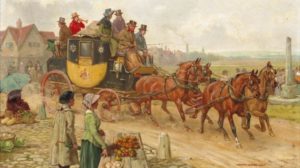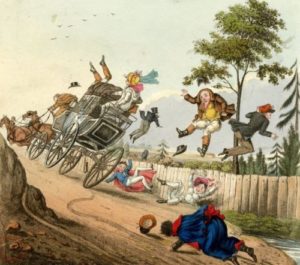 Travel in Regency England took many forms. While journeying to the nearest village, one usually walked or rode horseback, or, if wealthy, took the family coach. Travel to distant destinations, however, was different. Walking and horseback were impractical, and most family coaches had to travel slowly so as not to over-tire the horses. Wealthy people might send extra teams of horses ahead several days in advance to wait for them at various posting inns so they could be changed out upon arrival. This allowed them to continue their journey with a fresh team every so often. They might even board horses long-term at posting inns if that route was one they frequently used. Many lords did this along the main routes to London so they could reach it easily and without a lot of arrangements ahead of time.
Travel in Regency England took many forms. While journeying to the nearest village, one usually walked or rode horseback, or, if wealthy, took the family coach. Travel to distant destinations, however, was different. Walking and horseback were impractical, and most family coaches had to travel slowly so as not to over-tire the horses. Wealthy people might send extra teams of horses ahead several days in advance to wait for them at various posting inns so they could be changed out upon arrival. This allowed them to continue their journey with a fresh team every so often. They might even board horses long-term at posting inns if that route was one they frequently used. Many lords did this along the main routes to London so they could reach it easily and without a lot of arrangements ahead of time.
However, in many cases, people used the mail coach or the stagecoach. These coaches traveled on schedule much like today’s trains or airplanes.
One of the least expensive ways to travel was the Royal Mail. This ran over specific routes usually only once a day in either direction. They did not travel on Sundays or religious holidays, such as Easter or Christmas. The main coach’s purpose was to deliver the mail. Passengers were secondary, and the coachmen were very strict about keeping their schedule—even if it meant leaving a tardy passenger behind.
 Stage and mail coaches primarily stuck to the main highways but could take smaller routes—just less frequently. In well-established efficiency, they stopped at posting inns to change horses. Each posting inn along the stagecoach routes kept horses to switch out with incoming coaches. With the speed of a pit crew changing tires at a NASCAR race, men changed the horses for the mail or stagecoaches. According to several sources, they could do it in under 5 minutes. Some of these coaches had teams of four and some had six. Obviously, the more horses, the longer it took the change the team.
Stage and mail coaches primarily stuck to the main highways but could take smaller routes—just less frequently. In well-established efficiency, they stopped at posting inns to change horses. Each posting inn along the stagecoach routes kept horses to switch out with incoming coaches. With the speed of a pit crew changing tires at a NASCAR race, men changed the horses for the mail or stagecoaches. According to several sources, they could do it in under 5 minutes. Some of these coaches had teams of four and some had six. Obviously, the more horses, the longer it took the change the team.
Private companies owned various stagecoaches. These ran on their own schedules but kept to them as tightly as the mail coaches. They were dependable and often more crowded. They, too, were not supposed to run on Sundays or religious holidays, but some did in the interest of profit. The time they took to change horses was more relaxed and stops were worked into their schedules to give the passengers up to twenty minutes to get out to stretch, eat, and take care of personal needs.
Whether there was more than one stage or mail going out a day depended on the route. Generally, they ran once a day in each direction—or possibly even less depending on the route. Well-traveled roads leading to cities and larger towns had more frequent trips. Several coaches used the same main roads for part of the journey, then split off to reach various end destinations. The destination determined whether the next coach out would be in two hours or the next day.
Coaches stopped during severe weather such as blizzards, and when snow blocked the roads, however, they generally ran regardless of the cold or rain. In a couple of cases, outside passengers froze to death.
Getting a seat on a coach could be difficult. Most sold out days in advance, so it was not easy to simply “catch” a ride. One bought tickets at the origin point for the mail or stage. Coachmen could sometimes be bribed to stuff in a passenger or give them an outside seat on the top of the coach, but it was not always possible. Horses can only pull so much weight, after all.

Thank you for all the information. Enjoyed learning the difference between all the carriages.
Thanks so much for visiting my site!
Thank you! I always wondered how the horses were managed over long journeys without completely exhausting them.
So glad you found my blog post helpful. Thanks for stopping by.
How many passengers would fit inside a mail coach?
4 comfortably, but sometimes 6 crammed in. Also, if it were too crowded inside, people rode on top. It was dangerous up there–sometimes they fell off or died from exposure to the elements.
I’m wondering, did travelers in those times book or reserve a place at an Inn, if so how? Thanks.